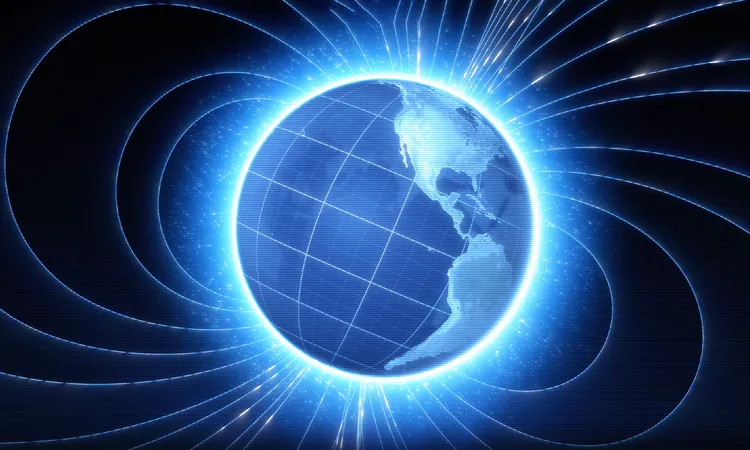
Groundbreaking Discovery: Earth's 'Invisible' Electric Field Found to Be as Essential as Gravity!
2025-03-26
Author: Jia
Groundbreaking Discovery of Earth's Ambipolar Electric Field
In a stunning reveal, NASA scientists have successfully measured an elusive global electric field that envelopes Earth, marking a significant milestone in atmospheric science. Dubbed the ambipolar electric field, this phenomenon is now believed to have as profound an impact on Earth as gravity or magnetism.
Origins of the Discovery
This groundbreaking finding originates from data gathered by NASA’s Endurance mission, which ascended into the upper atmosphere to explore the region linked to atmospheric escape—where particles escape into space. The existence of this ambipolar electric field has been theorized for over fifty years, as scientists sought to understand its influence on how charged particles, particularly at the polar regions, are expelled from the atmosphere.
The Polar Wind Mystery
The polar wind, a steady stream of air detected by spacecraft in the late 1960s above Earth’s poles, has perplexed scientists for decades. This outflow raised questions about how cold particles could travel at supersonic speeds without any significant heating. Glyn Collinson, the principal investigator of the Endurance mission at NASA's Goddard Space Flight Center, remarked, “Something had to be drawing these particles out of the atmosphere.”
Investigating Underlying Forces
While some researchers initially attributed this outflow to solar radiation, the consistent nature of the polar wind hinted at an additional underlying force—an undetected electric field. The Endurance mission was conceived to clarify these uncertainties, specifically targeting the upper atmosphere where such dynamics become more pronounced.
Endurance Mission Details
Selected as the launch location for this mission, Svalbard, a Norwegian archipelago, uniquely allows researchers to traverse the polar wind and make necessary measurements. On May 11, 2022, the Endurance rocket ascended to an altitude of 477.23 miles, where it recorded a mere 0.55 volts of electric potential—an amount akin to a weak watch battery, yet sufficient to explain the previously enigmatic polar wind.
Impact on Particle Movement
The electric field influences the movement of particles such as hydrogen, which is released at a force 10.6 times stronger than gravity. This means that these particles can escape into space at incredible speeds without the need for additional thermal energy. Moreover, oxygen ions also respond to this electric field, enabling atmospheric escape without raising temperatures—an explanation scientists had long sought.
Data Insights from the Endurance Mission
Data from the Endurance mission revealed that the ionosphere’s density increased by 271% at higher altitudes, indicating that this faint electric field consistently pushes significant amounts of the atmosphere beyond our planet's boundaries. “It’s like this conveyor belt, lifting the atmosphere up into space,” Collinson explained.
Implications of the Discovery
This discovery opens up new avenues for understanding atmospheric escape, which can occur on any planet with sufficient energy to lose particles over time. While solar activity was thought to be the main escape mechanism, the recently confirmed ambipolar field plays a critical role, suggesting a complex interplay between various forces acting on the atmosphere.
Broader Implications for Planetary Science
As researchers delve deeper into these mechanisms, the findings could illuminate the historical gases that compose our protective atmosphere and highlight how Earth has maintained a balance suitable for life over millions of years. Furthermore, this research has broader implications, shedding light on atmospheric processes on other planets, including Mars and Venus, where similar electric forces could influence their atmospheric properties.
Conclusion
In summary, the measurement of Earth's ambipolar electric field offers a crucial key to unraveling compelling mysteries not just about our own planet, but also about atmospheric behavior across the cosmos. Scientists believe every atmosphere-bearing planet is likely to have its own ambipolar field, paving the way for future studies that may define our understanding of life's potential on other worlds.
Publication and Future Research
This pivotal research has been published in the esteemed journal *Nature*, and it promises to reshape our comprehension of planetary atmospheres for years to come. Stay tuned for more exciting revelations from the frontiers of space exploration!



 Brasil (PT)
Brasil (PT)
 Canada (EN)
Canada (EN)
 Chile (ES)
Chile (ES)
 Česko (CS)
Česko (CS)
 대한민국 (KO)
대한민국 (KO)
 España (ES)
España (ES)
 France (FR)
France (FR)
 Hong Kong (EN)
Hong Kong (EN)
 Italia (IT)
Italia (IT)
 日本 (JA)
日本 (JA)
 Magyarország (HU)
Magyarország (HU)
 Norge (NO)
Norge (NO)
 Polska (PL)
Polska (PL)
 Schweiz (DE)
Schweiz (DE)
 Singapore (EN)
Singapore (EN)
 Sverige (SV)
Sverige (SV)
 Suomi (FI)
Suomi (FI)
 Türkiye (TR)
Türkiye (TR)
 الإمارات العربية المتحدة (AR)
الإمارات العربية المتحدة (AR)